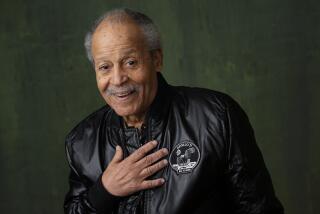J.F. ‘Skeets’ Coleman dies at 95; test pilot for perilous XFY-1 Pogo
- Share via
J.F. “Skeets” Coleman, who was the test pilot on one of the oddest military airplanes ever produced, died Tuesday of natural causes at an assisted-living facility in Oceanside, said his daughter, Nancy.
He was 95, a life span especially notable given the precariousness of the plane he tested in the 1950s, the Convair XFY-1. It was a vertical-takeoff-and-landing vehicle featured on the cover of the 1990 book “The World’s Worst Aircraft.”
“It was a project that looked really good on paper,” said Bill Yenne, author of “World’s Worst Aircraft” and several other aviation books. The Navy wanted the plane, which took off straight up like a helicopter before transitioning to horizontal for regular flight, to save space on aircraft carriers. After years in development, one XFY-1 was built, but much of its engineering was untested.
“No one wanted to fly it; there were no volunteers,” Coleman said in an interview for the “Reaching the Skies” BBC documentary series. “It was a developmental power plant, it was a developmental airplane, a developmental concept. It’s pretty hard to tie all of those together without having a lot of risk.”
Coleman was the only pilot to ever take the XFY-1 on a full-on flight and was awarded the Harmon Trophy in 1955 for his contribution to aviation.
“Coleman was one of the last people ever to venture aloft in a machine that nobody knew how to fly, that no simulator had proved would fly, and that no computer could promise would be controllable,” according to an article in the Air & Space magazine of the Smithsonian Museum where the XFY-1, nicknamed the Pogo, now resides.
James Francis Coleman was born June 2, 1918, in Chicago, the third of six children. He joined the Marines in 1941, serving as a fighter pilot on dive bombing missions in the Pacific during World War II. After the war he earned an aeronautical engineering degree at UCLA.
From 1948 to 1950 he oversaw the operation of the now-defunct Del Mar Airport. He later worked for several aviation companies, including North American Aviation and Fairchild, in sales and marketing.
In 1951, the Navy awarded Convair aircraft manufacturing a contract to design, build and test a vertical-takeoff-and-landing (VTOL) fighter. The XFY-1 was a so-called tail sitter because it sat straight up like a rocket, resting on four wheels attached to the edges of its wings and fins. It had a height of about 35 feet — the pilot had to use a long ladder to climb to the cockpit.
Coleman was in the Marine Reserves in 1954 when the Pogo was ready for testing, first inside a blimp hanger at Moffett Field south of San Francisco where he could practice takeoffs and hovering. A cable was attached to the nose of the Pogo in case a wrench operator had to be called upon to steady the plane.
“My call was ‘catch me, catch me,’” Coleman wrote in a report on the tests, “and I had to call him a lot.” Modifications were made to ease turbulence, and outdoor tests followed. The first successful full-on flight was Nov. 2, 1954, at Brown Field in San Diego and a few days later another was done for military and other officials to witness. The liftoffs and transitions went smoothly. The hard part was landing the Pogo.
To get the plane down, Coleman had to twist around and look over his shoulder, eyeballing the descent without instruments. It was like a driver maneuvering into a parallel parking space, except this vehicle was airborne and weighed more than 11,000 pounds, not counting fuel.
“It was a nightmare,” Yenne said, “and imagine doing that on rough seas, and at night.”
Coleman never had a mishap in test flying the Pogo, but after just a handful of full-on flights, tests were halted — the plane was considered too unwieldy to be practical. It’s currently in storage at the Smithsonian. There are no immediate plans to put it on display, a museum official said.
In addition to his daughter Nancy Coleman, who lives in Port Washington, N.Y., he is survived by daughter Jackie Remick of Del Mar; son Marty Coleman of Tulsa, Okla.; sister Betty McCabe of New Haven, Conn.; seven grandchildren and one great-grandchild.
More to Read
Start your day right
Sign up for Essential California for the L.A. Times biggest news, features and recommendations in your inbox six days a week.
You may occasionally receive promotional content from the Los Angeles Times.







